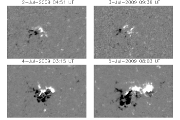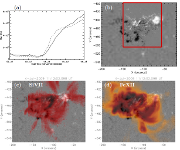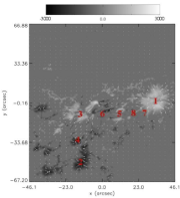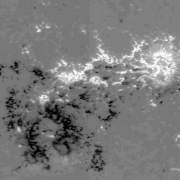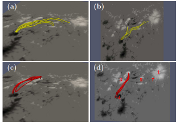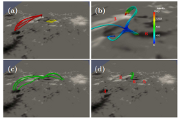
The process of flux emergence is currently modeled as the rise of a coherent, Ω-shaped flux rope from the base of the convection zone, through the photosphere and into the corona. Observations have shown that emerging flux carries currents which indicates the flux must be twisted. For instance, the presence of magnetic twist can be recognised due to the contribution of the azimuthal component, which shows up in longitudinal magnetograms as elongated polarities, called “magnetic tongues”. Due to the rapid outward decrease in plasma pressure at the photospheric level, immediately below it the flux accumulates and fragments before emergence into the atmosphere becomes possible. This fragmentation has its observational counterpart in the fine structure in the emerging regions, which suggest the presence of undulating “serpentine” field while the flux rope is breaking through the photosphere. Observationally, the serpentine field is seen as many small bipolar fragments in between the main, diverging, polarities. The last stage of the emergence evolution suggests that the emerged serpentine field lines are eventually re-organized to encompass the whole AR. Here we verify the above picture of emergence for the NOAA AR 11024.
NOAA AR 11024 was on the southern hemisphere, at about -27 degrees of latitude, with positive leading polarity, and it was globally bipolar both during its emergence and decay phases (see Animation 1 for a movie of the whole evolution). When it rotated over the east limb on 29 June 2009, the emerging AR was a tiny bipole, oriented in the same way as at the end of its growing phase, close to the western limb, when the magnetic field was essentially axial again (as inferred from the absence of magnetic tongues). Therefore, the early phase of emergence was likely to be formed by the top of axial field of the emerging flux tube. The AR remained relatively quiet until, at the end of 3 July 2009, suddenly the main phase of emergence occurred. At this time, the region was close to the central meridian. The rapidly emerging flux had the same magnetic configuration as the pre-existing AR, i.e., a positive leading polarity. However, the tilt of the new bipolar flux emergence was significantly higher than in the pre-existing region, which implies that an important azimuthal field component was emerging at this time. As a result, clear magnetic tongues were formed: The leading (positive) polarity of the emerging flux was observed to extend along the northern side of the following (negative) polarity, indicating that the flux had negative helicity. In between the main accumulations of the leading and following polarities, small bipolar flux regions were observed to emerge, which are normally interpreted as a photospheric signature of the serpentine field (see Figure 2). The emerged polarities either cancelled with the pre-existing field of opposite sign, or underwent coalescence with the like-polarity, as shown in Animation 2. The emergence of bipoles in the core of the AR lasted until 7 July 2009, when also the magnetic tongues were completely retracted. After the magnetic tongues retraction, the AR had again the structure of a large-scale bipole which got progressively dispersed by loosing flux (observed as moving magnetic features almost all around the sunspots). The total unsigned flux injected during the main phase of emergence was estimated in 6 x 1021 Mx, see Figure 1a.
At the time of the main emergence (4 July 2009), the AR was observed also by Hinode/SOT (see the SOT/SP vector magnetogram Figure 2, and the same magnetogram embedded in the MDI line of sight magnetogram in Figure 1b). Figures 1c,d show images of the EIS SiVII and EIS FeXII lines, probing the plasma at transition-region and coronal temperatures, on 4 July 2009 between 11:52:26-11:55:52 UT. Several features are visible, among which the western connection of the leading polarity 1 with the negative polarity 2 (cf. Figure 2), and a strong emission in the core of the AR at about x=-110″, well visible in the SiVII line of Figure 1c. By means of local correlation traking techniques it can be shown that, associated with the main phase of the emergence, there is a global flow that pushes southwards the negative polarity, and westwards the positive one. At smaller spatial scales, it also shows the motions of the emerging bipoles (see also the SOT/NFI movie of Animation 2). Finally, the flare spectrum reconstructed by the Reuven Ramaty High Energy Solar Spectroscopic Imager (RHESSI) shows several peaks in the considered emergence phase, all in the thermal range. In particular, three peaks in 3-6 and 6-12 KeV-ranges are found, all approximately located at (-100", -445") in heliographic coordinates, that are co-temporal with the SOT/SP scan (at 12:09, 12:13, and 12:24 UT). The location of the HXR emission is again in the region of the central strong emission in the SiVII image of Figure 1c noted above.
Nonlinear extrapolation provides a snapshot of the three-dimensional magnetic field at the time of the main emergence. The extrapolated field can then be employed to verify the above picture of the emergence obtained from photospheric and chromospheric signatures only. As an example, let us consider the magnetic connectivities of the compact negative polarity 4 (labeled in Figure 3d). Figures 3a,b show that the magnetic connectivity of polarity 4 spread over a relatively wide area on the positive polarity with an extension up to about 10 Mm in height. These field lines connect to the area of more dispersed polarity in the core of the AR (polarity 5, mostly), extending up to the periphery of the leading polarity 1 (in particular polarity 7), with clearly dipped, relatively low-lying field lines. These dips are partly overlying the area of flux emergence, and are an indication of a sea-serpent. In the proximity of the polarity 4, a second group of field lines, best visible if drawn from the northern part of the positive polarity 3 (Figures 3c-d), connects to the negative polarity 4 with a moderately negative twisted configuration overlaying the photospheric inversion line. Projected on the plane of the sky, this group of field lines has approximately the same location and shape of the bright loop (dark in reversed color table) visible in the EIS/SiVII image of Figure 1c at x=-110″ and approximately extending from y= -470″ to y=-440″. The connection between the elongated opposite polarities extending along the polarity inversion line recalls indeed the formation of magnetic tongues during the late stage of a flux rope emergence, as inferred from the photospheric signature in the line of sight magnetogram.
Combining the information from local correlation traking and extrapolation we can prove that the emergence has the form of a sea-serpent. Once serpentine field lines are emerged, they interact with the ambient magnetic field. Let us look at an exaple of such interactions. The emerging magnetic flux, connecting polarities 6 and 5 and associated with the sea-serpent configuration (in yellow in Figure 4a), drags the emerged Ω-loops toward a null point, shown in Figure 4b. The location of the null point in projection lies inside the area of strongest thermal emission registered by RHESSI at the time of the SOT/SP measurements. A first group of field lines formed by the reconnection process at the null point connects the adjacent polarities 3 and 6 (Figure 4d). The reconnection process also transforms field lines from the tongue structure (in red in Figure 4a) into lines connecting the sea-serpent polarity 5 to the negative polarity 4 of the tongue (Figure 4c). Such field lines have similar connectivity as the yellow field lines shown in Figure 3a,b, and may extend up to the leading polarity. This interpretation describes how the relatively short emerging serpentine field lines are transformed by successive reconnections into long-range field lines connecting the main polarity concentrations of the AR, and thus progressively re-build in the corona a presumedly similar connectivity that was present below the photosphere before the emergence.
Finally, at the time when the main emergence takes place on 4 July 2009, the relative magnetic helicity in a volume about 100″ high above the measured vector magnetogram is found to be -1.1 × 1042 Mx2 (-0.05 in units of magnetic flux), hence opposite in sign to the statistical hemispheric rule, but in agreement with the observed magnetic tongues. The estimated free energy in the same volume is 2.8 × 1032 erg, which could power an X-class flare while only B class flares were registered in the hours following the measurement of the vector field. In other words, our magnetic extrapolation reconstructs the coronal field during a quiet-time period of the active region.
In conclusion, we find a substantial agreement between the current interpretation of observed photospheric signatures of the emergence process and the snapshot of the three-dimensional magnetic field structure that is obtained by nonlinear extrapolation, which together provide a coherent picture of the emergence and evolution of AR 11024, both on the global AR as well as on the small serpentine scales.
This work was submitted in February 2011 to Solar Physics: G. Valori, L. M. Green, P. Démoulin, S. Vargas Domínguez, L. van Driel-Gesztelyi, A. Wallace, D. Baker, M. Fuhrmann, “Nonlinear force-free extrapolation of emerging flux with a global twist and serpentine fine structures”
| @ |

|
T. Török, L. Van Driel, G. Valori, J.-M. Malherbe (Obs Paris) in collaboration with KU Leuven, HVAR, UNIGRAZ, UGOE |

|

|

|
